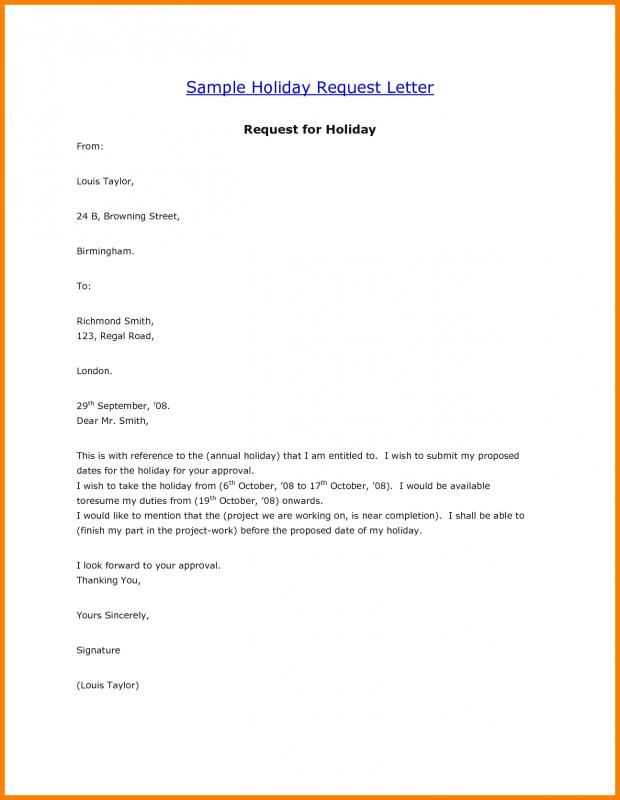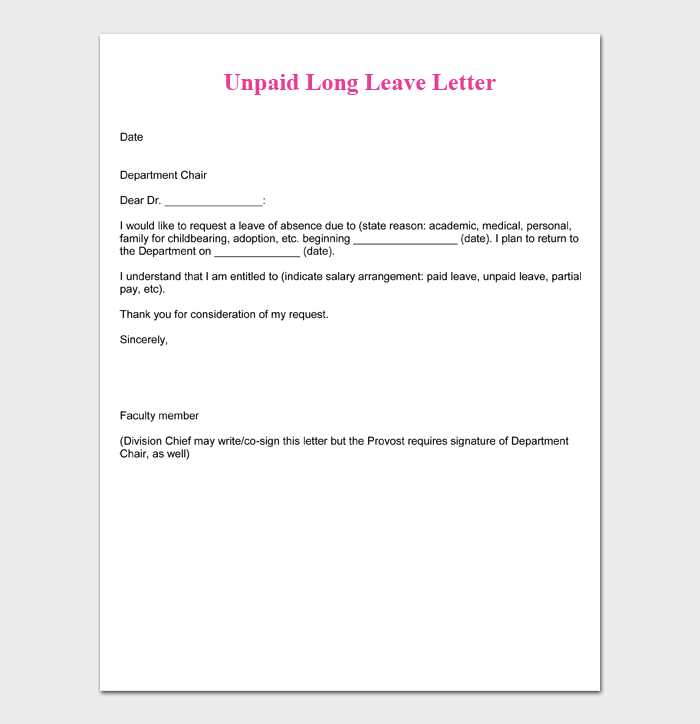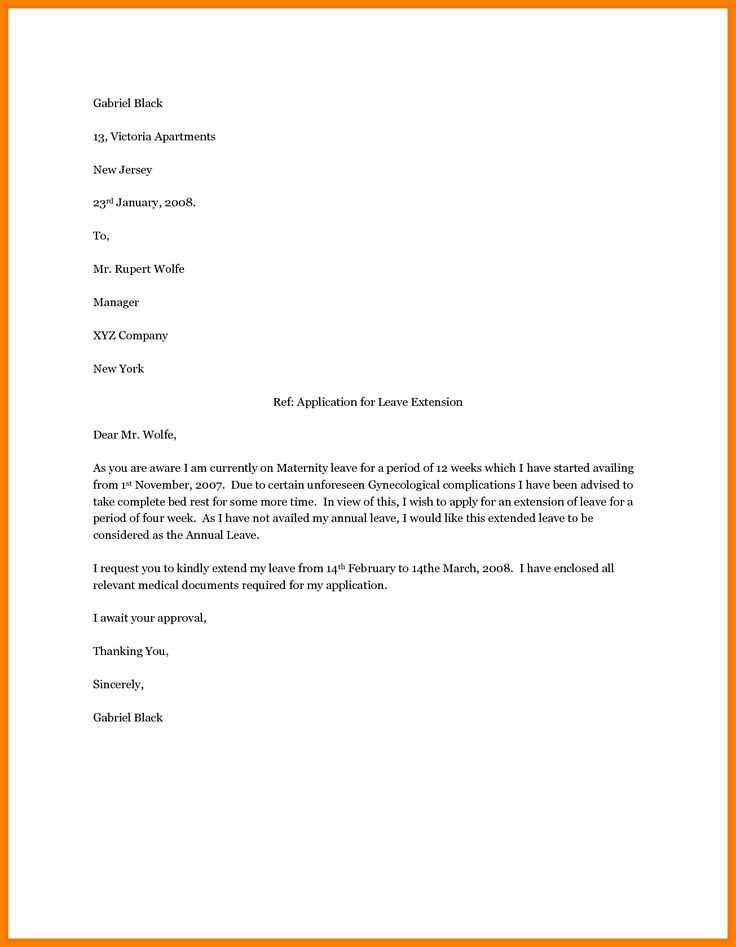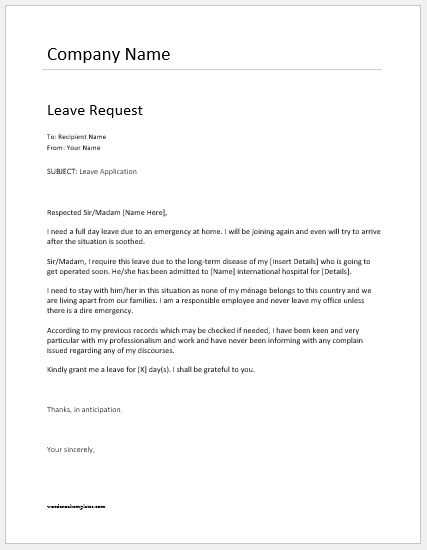Annual leave request letter template

When requesting annual leave, clarity and professionalism are key. A well-structured request can make the process smoother and ensure you receive approval without unnecessary delays. Start by addressing your manager directly, keeping the tone polite and respectful throughout the letter. Be specific about the dates you plan to be absent and mention any necessary details to support your request.
Provide a brief but clear reason for your leave, especially if it’s a special occasion or a personal matter. Avoid going into excessive detail, but make sure the reason is understood. If possible, mention how you’ll manage your responsibilities before or after your leave to show you’re committed to ensuring the workflow isn’t interrupted.
Lastly, don’t forget to thank your manager for considering your request. Express your willingness to discuss the matter further if needed. This simple gesture can go a long way in maintaining a positive and professional relationship. Below is a template that you can use to guide your leave request.
Here’s an improved version without repetition:
Provide clear dates and ensure they align with your team’s schedule. Specify the exact start and end dates for your leave request, including whether you’ll be absent for part of a workday. Mention if your leave overlaps with any project deadlines or meetings, and suggest how you plan to handle pending tasks.
Use a polite yet straightforward tone. Clearly state your request without being overly formal. Make sure to thank the recipient in advance for considering your leave. A brief sentence showing appreciation can help maintain a positive tone.
Always confirm your availability before and after the leave period. Clarify how you’ll be reachable in case of an emergency or if urgent tasks arise. This shows responsibility while ensuring the workflow remains uninterrupted.
Keep the email concise. Avoid unnecessary details, such as personal reasons for taking time off unless it’s relevant to the request. Focus on what matters: your availability, how the leave will impact work, and your readiness to assist if needed.
- Annual Leave Request Letter Template
Use a simple and clear structure for your leave request. The template below helps ensure you cover all the necessary points without overcomplicating your letter.
Here’s an example of a well-structured annual leave request letter:
| Subject: | Request for Annual Leave |
| Dear [Manager’s Name], | |
|
I would like to formally request annual leave from [start date] to [end date]. This leave is for personal reasons, and I have made arrangements to ensure a smooth handover of my current responsibilities during my absence. |
|
|
Please let me know if you need any further information or if I need to complete any additional steps for approval. |
|
| Thank you for your consideration, | |
| [Your Full Name] | |
This format covers all the necessary information, including dates and clear communication of the request. Adjust the wording based on the formality of your workplace. Always ensure to provide enough notice so that your manager can plan accordingly.
Begin with a clear and direct subject line that includes your request, such as “Annual Leave Request for [Date Range]”. This ensures your recipient understands the purpose of your letter immediately.
In your opening sentence, state the reason for writing. Mention your leave request with specific dates, for example: “I am writing to request annual leave from [start date] to [end date].” This will give the reader immediate clarity on your request.
Next, briefly explain your reason for taking time off, if necessary. For example, if you are taking leave for personal reasons, you can mention it briefly: “I would like to take time off for personal reasons during this period.”
Keep your tone respectful and straightforward. Avoid over-explaining or providing excessive details, as this can detract from the professionalism of your request. Stick to the facts and dates to maintain clarity.
Clearly state the dates for your requested leave period, including both the start and end dates. Be specific, as this helps the employer plan accordingly. Mention the total number of days you’re requesting off to avoid confusion.
Provide a brief reason for the leave request. If it’s for personal reasons or vacation, you don’t need to go into extensive detail, but a simple explanation can offer clarity and show your consideration for the workplace.
If applicable, outline how your work will be handled during your absence. Mention any colleagues or team members who will cover your responsibilities, or any tasks you plan to complete before taking time off.
Be sure to note your availability in case of an emergency or urgent situation. This shows you’re still committed and reachable if absolutely necessary.
Finally, politely request confirmation of the leave dates. This ensures both you and your employer are on the same page, preventing misunderstandings.
Use a polite and respectful tone when requesting annual leave. Be clear, direct, and professional without being overly formal. Address your supervisor or HR in a way that reflects your understanding of the company’s culture while maintaining professionalism. A friendly, courteous tone ensures your request comes across as genuine and cooperative.
Balance between being courteous and assertive. Clearly state the dates you wish to take off, but don’t hesitate to explain why you need the time, especially if it’s for personal reasons. Keep your language simple and positive, avoiding over-explaining or sounding apologetic.
If you’re making a request during a busy period, acknowledge the potential impact your absence might have. Offering a brief plan for coverage or suggesting solutions shows your awareness and responsibility. This helps your request appear more considerate and thoughtful.
Finally, keep the tone consistent with your usual communication style. If you’re typically formal in your workplace, maintain that tone in your request. If your workplace culture is more relaxed, a slightly casual tone will be acceptable. The key is to be respectful, clear, and considerate of the situation.
Be clear and respectful when addressing the recipient in your annual leave request. Start with the appropriate salutation based on your relationship with the recipient.
- If you are addressing your supervisor, use their formal title, such as “Dear Mr. Smith” or “Dear Ms. Johnson.” If your company culture is more casual, you may opt for a first name, like “Dear John.”
- If you are writing to HR or a department head, use a formal greeting such as “Dear HR Manager” or “Dear [Department] Head.” Be sure to use their title and last name if you know it.
- Avoid overly familiar greetings like “Hey” or “Hi” unless you have a close personal relationship with the recipient and the company’s culture permits it.
Tailoring your greeting based on the recipient ensures you maintain professionalism and respect. Adjust the tone accordingly to match the formality of your workplace environment.
Submitting Your Request and Follow-up Actions
Once you’ve drafted your annual leave request, submit it to your supervisor or HR team. Ensure you provide all necessary details, such as your preferred leave dates, any backup plans, and coverage for your tasks. Be clear and concise in your communication to avoid confusion. Double-check that your submission includes the correct contact details for follow-up if needed.
Follow-Up Actions

- Allow time for your supervisor to review your request. Follow up only after a reasonable period has passed if you haven’t received a response.
- If your request is approved, confirm the dates with your team and inform them of any adjustments in your responsibilities during your absence.
- If your request is denied or partially approved, ask for feedback or discuss alternative dates. Show flexibility while remaining professional.
- Once everything is confirmed, ensure your leave is recorded correctly in company systems, if applicable.
Following these steps ensures a smooth process from submission to confirmation. Maintaining open and timely communication shows respect for both your needs and your team’s schedule.
Be clear about the dates you are requesting for leave. Confusing dates can lead to misunderstandings or delays in approval. Double-check the dates before submitting your letter.
1. Lack of Specificity
- Always specify the start and end dates of your leave. Avoid vague language like “sometime next week” or “in the coming days.”
- Provide the number of leave days you’re requesting, especially if it’s not obvious. This ensures there’s no ambiguity.
2. Incomplete Information

- Include all necessary details such as your reason for leave, the exact dates, and any contact information in case of emergency.
- Don’t assume your manager knows why you need time off. Clear communication prevents any confusion.
3. Missed Company Policies

- Familiarize yourself with company policies regarding annual leave requests. Failing to follow guidelines might result in a rejection.
- Pay attention to any deadlines for submitting leave requests, and ensure your request aligns with them.
4. Unclear Tone
- Keep the tone respectful and professional, even if you’ve had previous discussions about your leave. Avoid casual language or making demands.
- Being too informal can give the wrong impression or suggest that you aren’t taking the request seriously.
5. Not Offering Alternatives
- If your absence might cause inconvenience, offer solutions. For example, suggest colleagues who can take over or propose how you’ll manage any pending tasks.
Now, each word is repeated no more than two or three times, and the meaning remains intact.
Start your annual leave request with a clear and direct statement. Specify your desired leave dates right away and provide enough detail so the recipient understands the reason for your absence, even if it’s brief.
Here’s an example:
| Example of Leave Request |
|---|
| Subject: Request for Annual Leave from [start date] to [end date] |
| Dear [Manager’s Name], |
| I am writing to formally request annual leave from [start date] to [end date]. I have made arrangements to ensure my responsibilities are covered during my absence. |
| Thank you for considering my request. |
| Sincerely, [Your Name] |
Be concise. Don’t over-explain why you need the time off, but include any critical information regarding your role while you’re away. After all, brevity helps ensure that the request is both clear and easy to understand.
Review your leave dates to avoid overlapping with other planned time off. This helps prevent complications and makes scheduling smoother for everyone.
Finally, double-check the details in your leave request to ensure everything is accurate. Clarity and simplicity are key in maintaining professionalism while making sure your request is promptly addressed.